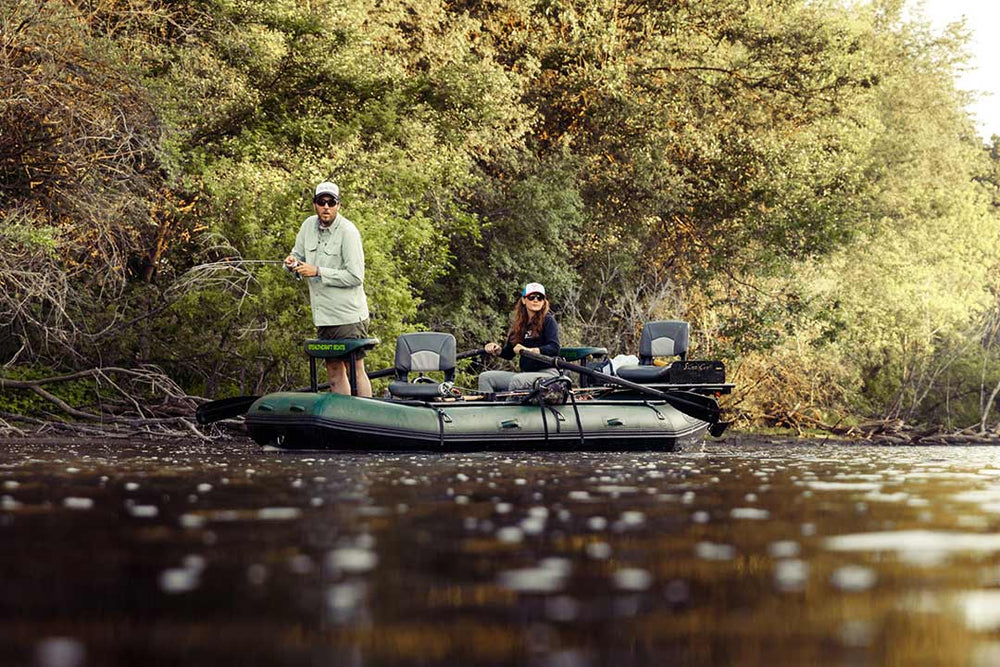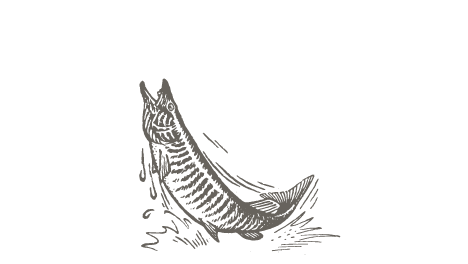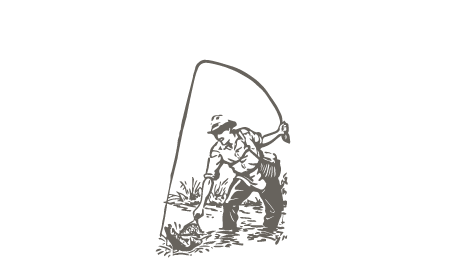Small Stream Muskies
I park my car at the edge of a dirt road. Google Maps shows that a small branch of a well known larger river is located just down the hill to my right. I see no sign that anyone fishes this place regularly. There isn’t even a path. But when I walk 75 yards to the river, I see a small rapids that lead to a fairly large pool. Positioning myself where the rapids empty into the pool, I cast a 5” Murdoch Minnow in such a way that it swings through the current and into the still water. Right on the line, as it crosses from swift water to still, I see the golden shape of a musky rush out and inhale it. First cast and fish on! It’s a small musky, maybe 28”, but who cares? This is fun and I have the whole day of exploring and fishing ahead of me.
The above describes my first experience on a small musky stream that I now fish regularly. I love wading small streams for muskies. I totally understand the thrill of pursuing large fish in larger bodies of water, but there is still a certain thrill that I can only find wading smaller streams. If you are a veteran musky angler looking for a new experience or a new musky fly angler looking for a way to ease yourself into the game, you might find that wading smaller rivers for muskies is exactly what you’re looking for.
First, you are going to catch fish. In my neck of the woods, certain small streams have a large number of small-ish muskies. Multiple fish days are not only possible, but common on these streams. While the fish aren’t likely to be big, they are likely to be aggressive and that means a pretty good EPH (eats per hour) ratio. This aggression is due to a lower density forage base in small streams. There just aren't the numbers of baitfish or suckers in these streams as there are in a large river or lake, so muskies in these waters tend to eat when they get the chance.
The second reason to wade small streams is that you can downsize your gear. If you’re new to musky fly fishing, casting a ten or twelve weight rod is daunting. On smaller water, an eight or nine weight is perfect and it can do double duty as a smallmouth rod. You can also fish smaller flies. Casting a five inch Murdich Minnow is certainly easier than a twelve-inch Game Changer when an angler is just starting out.
Thirdly, you are going to learn an awful lot about reading water and the kind of cover muskies like. This is going to be especially helpful if you plan to fish moving water regularly. Sometimes it can be pretty difficult to figure out exactly where to focus when fishing a large river. Small streams, on the other hand, are much easier to get a handle on. Frequently, all you need to do is locate the deep holes, which on smaller water are very easy to recognize, and you can be confident that you're throwing your fly into a musky’s living room. Because you are on foot, you have all the time in the world to study exactly how the hole is laid out and make mental notes of where in the hole the fish end up being. Later in your musky career, you’ll be amazed at how all this information can be scaled up to bigger water.
The last reason to wade small streams for muskies is that it’s just plain fun. There is something special about the way small water makes me focus. Time really does move at a different speed when I’m wading a small river. Frequently, I’ll put a few flies, lunch, and a beer or two into a small day pack and, with my dog at my side, head out for a day’s musky wading. The day goes by in what seems like no time. I often liken it to playing a golf course in that every bend in the river or other feature requires a different approach. I find myself totally immersed in the moment. It’s addictive
Stuff You’ll Need
Wading small streams for muskies is a minimalist’s dream. This really is an activity where packing light and thoughtfully is the way to go.
Rod: I use an 8 weight rod when I wade smaller water for muskies. You can also use it for smallmouth fishing or that spring-break bonefish trip to Belize. 80 percent of the time, an eight weight is a perfect match to the muskies you’ll encounter on small water and for those times when you do hook into a big fish, well, it’s fun to see a rod bend all the way to the cork.
Reel: Whatever. I would get a reel that meets my other 8 weight needs (bonefish in Belize) and not drop much more science on it than that.
Line: A line with a short and heavy head like a Rio Outbound, SA Titan Taper, or Cortland Compact is perfect for this application. I frequently use a 330 grain Cortland Smallmouth Bass line when wading for muskies for the simple reason that I also use it for smallmouth bass. When choosing a line, remember you are not going to need a lot of distance and finesse isn’t too important.
For wading, you are going to want either a floating line or a sink tip. Wading with full sink lines is no fun because the line you strip sinks and gets wrapped around your feet, rocks, whatever it can find. A floating line is often my choice because I’m generally not fishing water much deeper than four feet in the streams I wade. I will use a sink tip if the pools are deeper, the water is high or I want to fish more buoyant flies like small Bufords that need some help from the line to get down.
Leader: If you are using a floating line, you can use a little longer leader: maybe six feet. If you are using a sink tip, you’ll want a leader closer to three feet. Why the difference? The point of a sink tip is that the line is going to get the fly down. A long leader negates this, so a shorter leader is needed. My musky leaders all start with a section of 40# mono and end in a 12” section of 30# bite wire and a snap. Sometimes, if smallmouth are also in play, I’ll use 13# bite wire.
Flies: As I said earlier, small water muskies are likely to eat smaller offerings. I have a bunch of flies that I like to say are a little on the big side for smallmouth and a little on the small side for muskies. Murdoch Minnows, Dungeons, smaller single Bufords, all kinds of flies will work. Think flies in the 5” range. These are perfect for this application. I have a 5” pattern I tie that is half Dungeon and half Buford with lead dumbbell eyes. It fishes perfectly on a floating line, running about 3 feet deep on a moderate speed retrieve.
Tools: You’ll need all the normal musky tools such as a long reach needle-nose pliers and a side cutter. I generally don’t carry a large landing net with me because I cover a lot of water and a full-size musky boat net is hard to manage, so I bring a steelhead net and it works well for the small to medium sized fish that I generally encounter on smaller rivers. Remember that the safety of fish is essential, so bring the equipment you’ll need to get them unhooked and released as efficiently as possible. I find that if you make a point of pinching barbs, the unhooking process can go quickly. All of your stuff will fit in a sling pack or daypack.
Wading: On either end of the season, you’ll want waders. However, from June through September, a pair of wading shoes and some long quick-drying pants are all you’ll need. Remember, it’s no fun being cold, so look at the forecast and plan accordingly.
The most important thing about small stream musky fishing is to keep it simple. Pare down your kit to the essentials and get out there. Because that’s what really matters. Spending time in beautiful places chasing muskies is time well spent and I don’t know of a better way to spend a day than wading a small stream and hoping for that big eat.
*A note from Musky Fool - If you are specifically targeting larger muskies (40 inch+) we recommend using heavier tackle like a 10wt rod.






Leave a comment